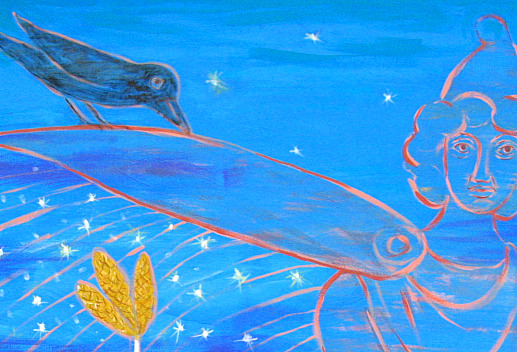
This image is a partial view of the painting. The full view is on the page Overview, and for a bigger format of the picture you can follow this link:
The Wind. The wind gods and Mithras rejecting to kill.
The Wind
With an emphasis on the width of the sky, that we see on the painting consisting of 5 separate parts, Mithras is positioned in the center and to his sides are the four wind-gods. Farangis shows Mithras here with the cosmical symbol elements. He is shown in his coat, that the wind blows open, the inside of the coat is the sky with its stars.
Mithras is sitting on the back of the steer, the steer holds his tail upwards and the tip of the tail is a threefold ear of grain. [The tip of the steers tail as a threefold ear of grain is a symbol taken from the ancient Persian mythology pertaining to the figure of Mithras.] Mithras is to be recognized in the moment of taking hold of the steers head, but with this picture Farangis has painted a position for the slayer that has not been depicted before like this, because here we see Mithras in his decision to refrain from killing the steer. By holding back the hand that wants to kill, he resists to become a murderer by divine command.
In the cosmical piety of the Mithras mysteries the raven plays an important role. The raven is mostly depicted as sitting on the wide coat of Mithras, and facing him directly. Since the dwelling places of birds are both sky and earth, birds often have been attributed a mediating role between the gods of heaven and the earthly world of people.
The four wind gods left and right, up and low, indicate the four wind directions. In many ancient languages wind is seen as closely related to breathing, breath and air. In this way, on this picture Mithras has not taken the animals breath, but has preserved life. He has integrated himself into the cycle of life within a cosmic order and he has withheld himself against the divine command to kill.
Werkzyklus
- See the first part of the Mithras Werkzyklus Zum Beispiel Mithras, Part I, on: https://farangis.de/mithras/.
On Mithraism
- The Roman Mithras mystery cult, Christianity and the sacrifice.
- The Persian deity Mithras. Click here to read about the historical initials of Mithraism.
Large view of the paintings
- The Suncircle
The torches held up and down by Cautes and Cautopates marking the revolvement of earth and sky. - The Wind
The wind gods and Mithras rejecting to kill. - The Slaying of the Bull
The sacrifice in the Mithras cult. - The Sacrifice in the Abrahamic Religions
The sacrifice as the equivocal link between man and god.
